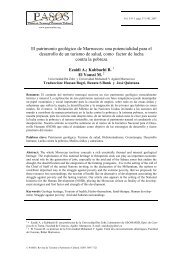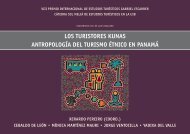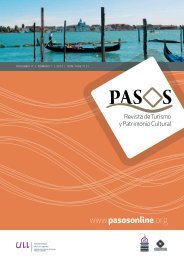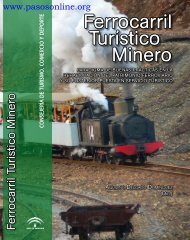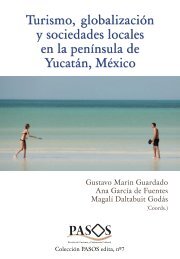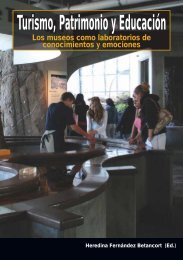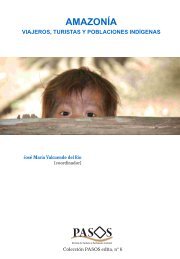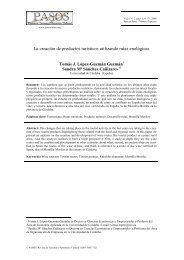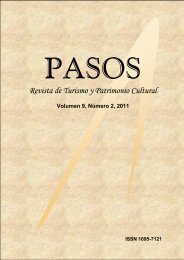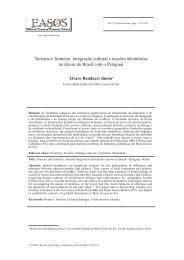Post Hoc Tourist Segmentation with Conjoint and Cluster ... - Pasos
Post Hoc Tourist Segmentation with Conjoint and Cluster ... - Pasos
Post Hoc Tourist Segmentation with Conjoint and Cluster ... - Pasos
Create successful ePaper yourself
Turn your PDF publications into a flip-book with our unique Google optimized e-Paper software.
Vol. 7 Nº3 págs. 491-501. 2009<br />
www.pasosonline.org<br />
<strong>Post</strong> <strong>Hoc</strong> <strong>Tourist</strong> <strong>Segmentation</strong> <strong>with</strong> <strong>Conjoint</strong> <strong>and</strong> <strong>Cluster</strong> Analysis<br />
Sérgio Dominique Ferreira Lopes i<br />
Universidad de Santiago de Compostela (España)<br />
Antonio Rial Boubeta ii<br />
Universidad de Santiago de Compostela (España)<br />
Jesús Varela Mallou iii<br />
Universidad de Santiago de Compostela (España)<br />
Abstract: In the present work, the authors want to illustrate the advantages of the combined use of the<br />
<strong>Conjoint</strong> Analysis <strong>and</strong> the <strong>Cluster</strong> Analysis in market segmentation. The benefits are easily underst<strong>and</strong>able<br />
since the <strong>Conjoint</strong> Analysis allows researchers to know the structure of the consumer’s preferences<br />
<strong>and</strong> the <strong>Cluster</strong> Analysis allows grouping those consumers by their preferences. So, <strong>with</strong> the enormous<br />
diversification that characterizes tourism, it doesn’t make sense segmenting market <strong>with</strong> a priori procedures.<br />
It’s preferable to carry out a post hoc segmentation in order to know more detailed <strong>and</strong> relevant<br />
information like tourists preferences (estimated <strong>with</strong> the <strong>Conjoint</strong> Analysis). This procedure creates a<br />
competitive advantage. Hence, segmenting markets based on the preferences of consumers allows researchers<br />
<strong>and</strong> professionals to better evaluate which the real preferences are (by clusters) <strong>and</strong> to better<br />
develop marketing strategies that better suit the consumers’ preferences.<br />
Key Words: Market <strong>Segmentation</strong>; <strong>Conjoint</strong> Analysis; <strong>Cluster</strong>s Analysis; <strong>Tourist</strong> Preferences.<br />
Resumen: En el presente trabajo los autores pretenden ilustrar las ventajas del uso combinado del Análisis<br />
Conjunto y del Análisis de Conglomerados, en la segmentación del mercado turístico. Los beneficios<br />
son fácilmente entendidos, una vez que el Análisis Conjunto permite a los investigadores conocer la<br />
estructura de las preferencias de los consumidores y el Análisis de Conglomerados los agrupa en segmentos,<br />
a partir de las preferencias de éstos. Habida cuenta de la enorme complejidad y diversificación<br />
que está adquiriendo el mercado turístico en nuestros días, carece de sentido adoptar estrategias de segmentación<br />
a priori, basadas únicamente en variables clásicas de corte sociodemográfico, cuya capacidad<br />
explicativa ha demostrado ser muy limitada. En su lugar, optar por procedimientos de segmentación post<br />
hoc, donde se incluya información más elaborada, como pueden ser las preferencias de los consumidores<br />
turistas (estimadas a partir de procedimientos estadísticos avanzados como el Análisis Conjunto), se<br />
convierte en una ventaja competitiva. La segmentación basada en las preferencias permite a investigadores<br />
y gestores disponer de un conocimiento más preciso del mercado y desarrollar estrategias de Marketing<br />
adecuadas a cada uno de los segmentos de interés.<br />
Palabras Clave: Segmentación de mercados, Análisis conjunto, Análisis de conglomerados, Preferencias<br />
de los turistas.<br />
i Universidad de Santiago de Compostela E-mail: sergiodominique.ferreira@usc.es<br />
ii Universidad de Santiago de Compostela E-mail: antonio.rial.boubeta@usc.es<br />
iii Universidad de Santiago de Compostela E-mail: jesus.varela@usc.es<br />
© PASOS. Revista de Turismo y Patrimonio Cultural. ISSN 1695-7121
492 <strong>Post</strong> <strong>Hoc</strong> <strong>Tourist</strong> <strong>Segmentation</strong> <strong>with</strong> <strong>Conjoint</strong> <strong>and</strong> <strong>Cluster</strong> Analysis<br />
Introduction<br />
Effectively, tourism is one of the most<br />
important sectors of the international economy.<br />
The UNWTO's Tourism 2020 Vision<br />
forecasts that international arrivals are<br />
expected to reach nearly 1.6 billion by the<br />
year 2020. Of these worldwide arrivals in<br />
2020, 1.2 billion will be intraregional <strong>and</strong><br />
378 million will be long-haul travellers. The<br />
total tourist arrivals by region shows that<br />
by 2020 the top three receiving regions will<br />
be Europe (717 million tourists), East Asia<br />
<strong>and</strong> the Pacific (397 million) <strong>and</strong> the<br />
Americas (282 million), followed by Africa,<br />
the Middle East <strong>and</strong> South Asia (table 1).<br />
Base Year Forecasts Market<br />
Share<br />
1995 2010 2020 (%)<br />
However, since mid-2008 we assisted to<br />
a rapid slowdown of international tourism<br />
growth (for the reason that oil’s price has<br />
increased a lot).<br />
So, this is a very important point that<br />
countries <strong>and</strong> the private sector related<br />
<strong>with</strong> tourism activity must be aware of <strong>and</strong><br />
they must take initiatives to be stronger to<br />
face new difficult times that are coming,<br />
(“one of the biggest crisis”).<br />
In this context, Portugal is one of the top<br />
20 international countries in terms of tourist<br />
arrivals (concretely about 11.5 millions).<br />
Tourism is a vital sector of the Portuguese<br />
economy, representing about 11% of national<br />
GDP <strong>and</strong> 10% of the national employment.<br />
This way, all efforts must be<br />
done to maximize the profitability of the<br />
resources <strong>and</strong> the investments made.<br />
A very important point is that about<br />
80% of Europeans live in urban areas <strong>and</strong><br />
they want to come back to the "field life" as<br />
a form of recreation <strong>and</strong> leisure occupation.<br />
So, if we think that the Iberian Peninsula<br />
has 80% of the biodiversity of the European<br />
Union, Portugal (<strong>with</strong> particularity Northern<br />
of Portugal) should seriously focus on<br />
this eco-tourism. Therefore, all the investments<br />
made from the national government<br />
<strong>and</strong> from the private investments should be<br />
strategically done to safeguard the quality<br />
<strong>and</strong> the diversity of the biological life in<br />
these regions, in order to capture the<br />
maximum of tourists (incomes) as possible<br />
(INE, 2008).<br />
In regions like the Interior of Portugal,<br />
where the economy doesn’t reach the most<br />
desired levels, the tourist activity has increased<br />
but not in a satisfactory way. Thus,<br />
Average<br />
Annual<br />
Growth<br />
Rate (%)<br />
(Million) 1995 2020 1995-2020<br />
World 565 1006 1561 100 100 4.1<br />
Africa 20 47 77 3.6 5.0 5.5<br />
Americas 110 190 282 19.3 18.1 3.8<br />
East Asia <strong>and</strong><br />
the Pacific<br />
81 195 397 14.4 25.4 6.5<br />
Europe 336 527 717 59.8 45.9 3.1<br />
Middle East 14 36 69 2.2 4.4 6.7<br />
South Asia 4 11 19 0.7 1.2 6.2<br />
Table 1. <strong>Tourist</strong> arrivals, market share <strong>and</strong> average growth rate<br />
each tourism product<br />
that is strategically<br />
oriented represents a<br />
crucial factor to<br />
achieve a sustainable<br />
economic growth for<br />
those regions. This<br />
way, attributes like<br />
the quality of the environment<br />
can be improved.<br />
The Ecotourism<br />
represents more<br />
than 10% of the market<br />
<strong>and</strong> it’s currently<br />
the sector of the Portuguese<br />
tourism that<br />
must increases.<br />
In fact, it’s not illusory the enormous<br />
importance that tourism has on the social<br />
<strong>and</strong> economic prosperity of a country, concretely<br />
in the case of Portugal. Factors such<br />
as the creation of jobs, directly <strong>and</strong> indirectly<br />
(in hotels, restaurants, etc.) have a<br />
direct <strong>and</strong> a significant impact on the GDP<br />
<strong>and</strong> on the br<strong>and</strong> image of a country, at a<br />
national <strong>and</strong> international level. In the<br />
context of an increasing globalization <strong>and</strong><br />
international competition, tourism is a<br />
paramount sector <strong>and</strong> it’s a strategic sector<br />
of growth for a country (certainly is in the<br />
case of Portugal).<br />
Therefore, it’s very important to develop<br />
this sector <strong>and</strong> all the researches should be<br />
conducted <strong>with</strong> consistent methods <strong>and</strong><br />
consistent goals, to carry out an ambitious<br />
plan in Portugal <strong>and</strong> in the others strategic<br />
countries for the Portuguese tourism. As a<br />
result, Portugal should take advantage of<br />
its tourism potential strategically, to<br />
PASOS. Revista de Turismo y Patrimonio Cultural, 7(3). 2009 ISSN 1695-7121
Sérgio Dominique Ferreira Lopes, Antonio Rial Boubeta <strong>and</strong> Jesús Varela Mallou 493<br />
maximize the profitability.<br />
In this context, Portugal must fallow the<br />
marketing strategies of Spain <strong>and</strong> France<br />
(international leaders in terms of tourism<br />
revenues). Such countries have one common<br />
factor: they guide themselves by a<br />
strong marketing approach in the management<br />
of their tourism resources. And<br />
the recent history confirms that those countries<br />
(France <strong>and</strong> Spain) are the most competitive<br />
in the world. This phenomenon can<br />
be explained by several factors, such as: a)<br />
a huge professionalization of all sectors<br />
related <strong>with</strong> tourism; b) the marketing <strong>and</strong><br />
the sales of this sector (travel agents) are<br />
carefully structured; c) the strategy of<br />
management is very well coordinated because:<br />
i) the promotion is very weighted; ii)<br />
the offer is adjusted to the consumers’<br />
needs <strong>and</strong> preferences; iii) <strong>and</strong> a structured<br />
strategy for the consumers’ loyalty through<br />
marketing campaigns (e.g.: in strategic<br />
locations - fairs).<br />
Based on the assumption that all processes<br />
that are part of Tourism Marketing<br />
(described above) have in their essence to<br />
meet the needs <strong>and</strong> the preferences of tourists,<br />
it’s essential to know which the structures<br />
of the tourist preferences are. This<br />
allows segmenting market into clusters<br />
that share homogenous preferences.<br />
Santesmases (1999, p.214) states that<br />
segmenting markets is the "process of dividing<br />
the market into homogeneous<br />
groups in order to carry out a marketing<br />
strategy to each one, allowing to satisfy<br />
more effectively their needs <strong>and</strong> to achieve<br />
the commercial objectives of the company. "<br />
According to the same author (Santesmases,<br />
1999), segmenting markets presents<br />
several advantages, such as finding markets<br />
that are not saturated, i.e., where<br />
there are still business opportunities; it<br />
allows to set priorities; it facilitates the<br />
analysis of competition, providing information<br />
about who are the direct competitors<br />
<strong>and</strong> allows companies to offer products/services<br />
that best suit specific needs of<br />
each segment.<br />
Nowadays, market researchers analyse<br />
products <strong>and</strong> services as a set of characteristics<br />
or attributes <strong>and</strong> these products tend<br />
to be configured according to the consumers’<br />
needs <strong>and</strong> preferences. So, it’s important<br />
to know which the assessment of those<br />
attributes is <strong>and</strong> to know in which way<br />
each attribute <strong>and</strong> level of attribute contribute<br />
to elect a certain product. Therefore,<br />
<strong>Conjoint</strong> Analysis is very useful to<br />
analyze the consumers’ preferences (Wittink<br />
& Cattin, 1989; Wittink, Vriens &<br />
Burhenne, 1994).<br />
As it’s currently known, it’s not possible<br />
to please everyone’s needs, so it’s inevitable<br />
segmenting markets. Hence, business organizations<br />
need to group consumers into<br />
segments, to satisfy their needs <strong>and</strong> to increase<br />
their level of satisfaction. Therefore,<br />
the better is the segmentation the better<br />
will be the adjustment of the products to<br />
the consumers’ preferences.<br />
Until today, there are just a few empirical<br />
researches in tourism <strong>with</strong> real methodological<br />
basis. Spain, <strong>and</strong> more specifically<br />
Galicia, has been consolidating in<br />
recent years a strong marketing approach<br />
for the management of tourism resources,<br />
being a good example to follow by other<br />
countries.<br />
In this context, <strong>Conjoint</strong> Analysis is a<br />
methodology that has its origins in the Psychology<br />
<strong>and</strong> in Marketing. The works of<br />
Luce <strong>and</strong> Tukey (1964) are the first references<br />
<strong>and</strong>, later, Wilkie & Pessemier (1973)<br />
started to talk about multi-attribute models,<br />
as a way to analyze <strong>and</strong> underst<strong>and</strong> the<br />
preferences of the consumers (Varela &<br />
Braña, 1996; Picón & Varela, 2000; Braña,<br />
Rial & Varela, 2001; Picón, Braña &<br />
Varela, 2002; Picón, Varela & Braña, 2006;<br />
Ramírez, 2008).<br />
Like this, the multi-attribute models explain<br />
the way that consumers former their<br />
preferences (for products or services). So,<br />
preferences are created by the consumers’<br />
perception <strong>and</strong> the main goal of the <strong>Conjoint</strong><br />
Analysis is to estimate the value of<br />
each characteristic or levels of attribute<br />
that defines a product. With these values,<br />
it’s possible to know which the characteristics<br />
of the consumers’ behaviours are. And<br />
the compensatory models (Fishbein &<br />
Ajzen, 1975) are linked to the multiattribute<br />
models <strong>and</strong> the various levels of<br />
attributes can compensate each other. It’s<br />
PASOS. Revista de Turismo y Patrimonio Cultural, 7(3). 2009 ISSN 1695-7121
494 <strong>Post</strong> <strong>Hoc</strong> <strong>Tourist</strong> <strong>Segmentation</strong> <strong>with</strong> <strong>Conjoint</strong> <strong>and</strong> <strong>Cluster</strong> Analysis<br />
possible to find very different products <strong>with</strong><br />
very similar global utilities or preference<br />
because the different levels of attribute of a<br />
product act together in the consumers’<br />
mind <strong>and</strong> perception.<br />
A classic segmentation (a priori segmentation)<br />
groups consumers that share the<br />
same socio-demographic characteristics<br />
(age, gender, etc). But, in reality, it doesn’t<br />
group the consumers by the similarity of<br />
their preferences. It’s almost about describing<br />
the consumers by their sociodemographic<br />
profile.<br />
But a post segmentation that combines<br />
<strong>Conjoint</strong> Analysis <strong>and</strong> <strong>Cluster</strong> Analysis<br />
brings important benefits (Picón, 2000).<br />
More specifically, <strong>Conjoint</strong> Analysis allows<br />
professionals to know the structure of the<br />
consumers’ preferences <strong>and</strong>, therefore, it’s<br />
possible to group those consumers into<br />
segments by their similarity of preferences<br />
(Picón, 2004; Picón & Varela, 2004; Varela,<br />
Picón & Braña, 2004).<br />
This way, it would be possible to proceed<br />
to an integral segmentation, i.e., a segmentation<br />
based on the consumers’ preferences<br />
information <strong>and</strong> on their socio-demographic<br />
profile. To each group resultant it will be<br />
associated a different kind of destination<br />
(preference).<br />
Traditionally, there are two basic<br />
ways of segmenting markets (Green,<br />
Carroll & Carmone, 1977; Wind, 1978):<br />
a) a priori <strong>Segmentation</strong>: in this kind of<br />
segmentation, the number of segments<br />
(groups) as well as its description is established<br />
before the study is carried out.<br />
The professionals choose from the beginning<br />
some basis to start the study, for<br />
example, the use of a product, the main<br />
benefit searched, needs, loyalty to a<br />
br<strong>and</strong>, etc, <strong>and</strong> then, they (professionals)<br />
assign consumers into groups; b) a post<br />
hoc segmentation: when the consumers’<br />
characteristics or their reactions to a<br />
new product are not known, it’s better to<br />
realize a post hoc segmentation. This<br />
way, the number of groups, the number<br />
of subjects in each cluster <strong>and</strong> its description<br />
are known just after the analysis<br />
is made. The resultant groups are constituted<br />
by consumers <strong>with</strong> more homogeneity<br />
between their preferences <strong>and</strong> there is<br />
more heterogeneity in the preferences of<br />
the groups than in a priori segmentation.<br />
Objectives<br />
The major objective of the current article<br />
is to illustrate the importance <strong>and</strong> the<br />
benefits of the combined application of the<br />
<strong>Conjoint</strong> Analysis <strong>and</strong> the <strong>Cluster</strong> Analysis.<br />
This allows professionals to identify groups<br />
of tourists <strong>with</strong> particular needs <strong>and</strong> preferences.<br />
This way, a segmentation based on<br />
the consumers’ preferences allows researchers<br />
<strong>and</strong> professionals to know more<br />
precisely the market <strong>and</strong> to develop Marketing<br />
strategies more appropriate to each<br />
group.<br />
Methodology<br />
A total of 300 young (96 males <strong>and</strong> 204<br />
females) were interviewed, <strong>with</strong> ages from<br />
18 to 35 years old (mean = 23.53; st<strong>and</strong>ard<br />
deviation = 4.595), residents in the Oporto<br />
city. It was explained to all the subjects<br />
that the task should be made <strong>with</strong> the utmost<br />
concentration <strong>and</strong> seriousness.<br />
Attributes <strong>and</strong> levels’ Selection<br />
ATTRIBUTES<br />
LEVELS<br />
Sun<br />
Weather<br />
Cold or Snow<br />
Rain<br />
High<br />
Cultural Offer<br />
Low<br />
Beach<br />
Nature or Mountain<br />
Kind of Destination<br />
City<br />
High<br />
Leisure Offer <strong>and</strong> Night Fun<br />
Low<br />
Until 300€<br />
300€ - 600€<br />
Price<br />
600€ - 1000€<br />
> 1000€<br />
2-3 Days (Weekend)<br />
Time of Permanency<br />
1 Week<br />
2 Weeks<br />
Table 2. Attributes <strong>and</strong> attributes’ levels used<br />
The present work is part of a larger<br />
study (the main aim was to know the tourist<br />
preferences of young people from Northern<br />
Portugal). The attributes <strong>and</strong> levels<br />
of attribute selected were based on two<br />
elements: a) the existent bibliography<br />
PASOS. Revista de Turismo y Patrimonio Cultural, 7(3). 2009 ISSN 1695-7121
Sérgio Dominique Ferreira Lopes, Antonio Rial Boubeta <strong>and</strong> Jesús Varela Mallou 495<br />
(Goodrich, 1978; Muller, 1995; Baloglu &<br />
McCleary, 1999; Gallarza, Gil & Calderón,<br />
2002; Picón & Varela, 2000; Varela, Picón<br />
& Braña, 2004; Rodríguez & Molina, 2007;<br />
Rial, Varela & García, 2008); b) <strong>and</strong> it was<br />
made a previous pilot study <strong>with</strong> a sample<br />
of 100 students to know which the most<br />
important attributes were. The elected attributes<br />
were: Weather, Cultural Offer,<br />
Kind of Destination, Leisure Offer <strong>and</strong><br />
Night Fun, Price <strong>and</strong> Time of Permanency.<br />
Stimuli<br />
To achieve the <strong>Conjoint</strong> Analysis we selected<br />
this six attributes of tourism destination,<br />
<strong>with</strong> different levels for each<br />
(3x4x2x2x4x3). From the 576 possible combinations,<br />
we used an orthogonal fractional<br />
factorial design, being selected 16 of them,<br />
which were eventually used in the data<br />
collection (<strong>with</strong> an Orthoplan procedure of<br />
the SPSS software). We built 16 cards, each<br />
one representing one of the sixteen combinations<br />
of the levels of attribute.<br />
Figure 1. An example of a card.<br />
Procedure<br />
It was asked to the subjects<br />
that in the first minutes<br />
they should analyse<br />
every cards <strong>and</strong>, then,<br />
they should sort those<br />
cards based on their preferences.<br />
This procedure is<br />
called Full Profile, <strong>with</strong><br />
Simulated Stimuli <strong>and</strong><br />
sort cards (Sequence).<br />
By the application of the <strong>Conjoint</strong><br />
Analysis to the entire sample, we can state<br />
that the most important attribute is<br />
Weather, <strong>with</strong> 31.5% of importance, followed<br />
by the attribute Cultural Offer, <strong>with</strong><br />
an importance of 22.9%. In third place, in<br />
terms of importance, is the attribute Leisure<br />
Offer <strong>and</strong> Night Fun (16.6%); in fourth<br />
place comes the attribute Time of Permanency<br />
<strong>with</strong> an importance of 12.59%. In<br />
fifth <strong>and</strong> penultimate place comes the attribute<br />
Kind of Destination, <strong>with</strong> an importance<br />
of 15.57%. And in sixth place comes<br />
the attribute Price, <strong>with</strong> an importance of<br />
3.76%. These results can be observed on<br />
figure 2.<br />
In terms of part-worths of the levels of attribute,<br />
the results show that in the attribute<br />
Weather, the preferred level is Sun<br />
<strong>with</strong> a part-worth of 1.79; the level Cold or<br />
Snow has a part-worth of (-1.017) <strong>and</strong> the<br />
level Tepid or Humid has a part-worth of (-<br />
0.78). About the attribute Cultural Offer,<br />
it’s possible to say that the preferred level<br />
is an High Offer <strong>with</strong> a part-worth of 1.023,<br />
<strong>and</strong> the opposite offer (Low) has a partworth<br />
of (-1.023). In the attribute Kind of<br />
Destination, the preferred level is Beach,<br />
<strong>with</strong> a part-worth of 0.634. In the attribute<br />
Leisure Offer <strong>and</strong> Night Fun, the level<br />
High Offer presents a part-worth of 0.743.<br />
The preferred level of the attribute Price is<br />
Data Analysis<br />
Data was collected from<br />
300 subjects (300 x 16),<br />
<strong>and</strong> it was analysed <strong>with</strong><br />
the <strong>Conjoint</strong> Algorithm <strong>and</strong> a <strong>Cluster</strong>ing<br />
Algorithm.<br />
Results<br />
Model fit is very high, so we can conclude<br />
that validity of the results is high<br />
(Pearson’s R=0.999; Kendall tau=0.967).<br />
Figure 2. Attributes’ Importance<br />
Until 300€ <strong>with</strong> a part-worth of 0.189.<br />
And for the attribute Time of Permanency,<br />
the preferred level is 2 Weeks <strong>with</strong> a partworth<br />
of 0.436. These results can be observed<br />
in figure 3.<br />
PASOS. Revista de Turismo y Patrimonio Cultural, 7(3). 2009 ISSN 1695-7121
496 <strong>Post</strong> <strong>Hoc</strong> <strong>Tourist</strong> <strong>Segmentation</strong> <strong>with</strong> <strong>Conjoint</strong> <strong>and</strong> <strong>Cluster</strong> Analysis<br />
Figure 3. Levels of attributes <strong>and</strong> correspondent part-worth<br />
Figure 4. Ideal destination (of the entire<br />
sample).<br />
<strong>Conjoint</strong> Analysis allows researchers to<br />
know which the ideal destination is. This is<br />
made by summing all the part-worths of<br />
the preferred levels <strong>and</strong> the value of the<br />
constant. And this ideal destination would<br />
be:<br />
So, if we sum all part-worths <strong>and</strong> the<br />
value of the constant, we have:<br />
1.797 + 1.023 + 0.634 + 0.743 + 0.184 +<br />
0.436 + 8.064 = 12.881<br />
So, the global importance of this ideal<br />
destination would be 12.881.<br />
So, some advantages of using the <strong>Conjoint</strong><br />
Analysis were illustrated. But, the<br />
real advantage of those results is that they<br />
can be used by the <strong>Cluster</strong> Analysis (as<br />
input). It allows researchers segmenting<br />
markets based on the similarity of the<br />
structure of preferences (of tourists). Subsequently,<br />
using both methodologies we<br />
obtained five clusters (figure 5).<br />
PASOS. Revista de Turismo y Patrimonio Cultural, 7(3). 2009 ISSN 1695-7121
Sérgio Dominique Ferreira Lopes, Antonio Rial Boubeta <strong>and</strong> Jesús Varela Mallou 497<br />
Figure 5. Typology of young tourist in orthern Portugal <strong>with</strong> clusters.<br />
Group 1: Sun Seekers (24%)<br />
This group is characterised by an preference<br />
for Weather <strong>with</strong> an importance of<br />
58.1%, being the favourite level Sun <strong>with</strong> a<br />
utility (u) of 4.58;<br />
Group 2: Culture Seekers (24%)<br />
This one is characterised by a large<br />
preference for Culture Offer <strong>with</strong> an importance<br />
of 56.04%, being the preferred level<br />
High cultural offer (u = 2.94);<br />
Group 3: Cheap Seekers (13%)<br />
They are a group that gives huge importance<br />
to the Price paid by a tourist travel;<br />
the importance of the attribute Price is<br />
52.32%, being the preferred price Until<br />
300€ (u = 1.91);<br />
<strong>Cluster</strong> 4: Beach Lovers (16%)<br />
These subjects are characterised by a<br />
large preference for Kind of Destination<br />
<strong>with</strong> an importance of 45.87%, being the<br />
favourite level Beach (u = 1.90);<br />
<strong>Cluster</strong> 5: Night Lovers (22%)<br />
These ones are characterised by a large<br />
preference for Night Fun <strong>with</strong> an importance<br />
of 28.92% <strong>and</strong> for a long time on holidays<br />
<strong>with</strong> an importance of 29.09%.<br />
Figure 6. Attributes’ importance by clusters<br />
PASOS. Revista de Turismo y Patrimonio Cultural, 7(3). 2009 ISSN 1695-7121
498 <strong>Post</strong> <strong>Hoc</strong> <strong>Tourist</strong> <strong>Segmentation</strong> <strong>with</strong> <strong>Conjoint</strong> <strong>and</strong> <strong>Cluster</strong> Analysis<br />
So, knowing the real preferences of each<br />
cluster, it’s possible, for example, to design<br />
or promote destinations that suit the particular<br />
preferences of each cluster. For<br />
instance, to Group 1 (Sun Seekers) it would<br />
be appropriate to promote a tourist destination<br />
where the Weather is very often<br />
Sunny; to Group 5 (Night Lovers) it would<br />
be more appropriated to promote a tourist<br />
destination mentioning that it has many<br />
pubs, discotheques <strong>and</strong> bars, i.e., the night<br />
life offer would be very complete.<br />
Through these results (table 3), it’s possible<br />
to state that all the part-worths of the<br />
levels of attribute are very different in<br />
every cluster. That is, the subjects have<br />
been assigned into clusters, presenting<br />
part-worths significantly different between<br />
them. These results allow validating the<br />
advantages of the current application of the<br />
<strong>Cluster</strong> Analysis since what differentiates<br />
the subjects of those five clusters is their<br />
preferences <strong>and</strong> not their sociodemographic<br />
characteristics. This is one of<br />
the reasons why it’s advisable to carry out<br />
a post hoc segmentation based on the consumers’<br />
preferences (Picón & Varela, 2000).<br />
Through table 4, it’s possible to state<br />
that clusters present a socio-demographic<br />
very similar composition, except for gender.<br />
This way, the preferences of young tourist<br />
of Northern Portugal can’t be explained<br />
based simply on socio-demographic characteristics<br />
because there isn’t a concrete<br />
socio-demographic profile. Subjects have<br />
been assigned into clusters not because of<br />
sharing socio-demographic characteristics,<br />
but because they share tourism preferences.<br />
<strong>Cluster</strong> Error F Sig.<br />
Quadratic<br />
Mean df<br />
Quadratic<br />
Mean df<br />
Quadratic<br />
Mean df<br />
SUN 189,378 4 1,582 295 119,725 ,000<br />
COLD-SNOW 65,804 4 2,935 295 22,418 ,000<br />
TEPID-HÚMID 52,365 4 2,843 295 18,419 ,000<br />
HIGH CULTURAL OF-<br />
FER<br />
91,381 4 ,972 295 94,011 ,000<br />
LOW CULTURAL OFFER 91,381 4 ,972 295 94,011 ,000<br />
BEACH 38,743 4 1,849 295 20,958 ,000<br />
CITY 103,842 4 1,836 295 56,558 ,000<br />
NATURE-MOUNTAIN 37,299 4 2,168 295 17,205 ,000<br />
HIGH LEISURE OFFER<br />
AND NIGHT OFFER<br />
30,396 4 1,139 295 26,684 ,000<br />
LOW LEISURE OFFER<br />
AND NIGHT OFFER<br />
30,396 4 1,139 295 26,684 ,000<br />
UNTIL 300€ 35,531 4 2,516 295 14,124 ,000<br />
BETWEEN 300€ AND<br />
600€<br />
33,705 4 2,024 295 16,652 ,000<br />
BETWEEN 600€ AND<br />
1000€<br />
6,349 4 2,595 295 2,446 ,047<br />
MORE THAN 1000€ 87,454 4 2,468 295 35,436 ,000<br />
2-3 DAYS (WEEKEND) 38,084 4 1,948 295 19,551 ,000<br />
ONE WEEK 20,344 4 1,638 295 12,421 ,000<br />
TWO WEEKS 60,221 4 2,004 295 30,051 ,000<br />
Table 3. ANOVA <strong>with</strong> the levels of attributes by clusters<br />
PASOS. Revista de Turismo y Patrimonio Cultural, 7(3). 2009 ISSN 1695-7121
Sérgio Dominique Ferreira Lopes, Antonio Rial Boubeta <strong>and</strong> Jesús Varela Mallou 499<br />
<strong>Cluster</strong>s<br />
Gender Chi-square 13,234<br />
df 4<br />
Sig. ,010<br />
Occupation Chi-square 1,487<br />
df 4<br />
Sig. ,829<br />
Incomings Chi-square 14,769<br />
df 20<br />
Sig. ,789<br />
Civil status Chi-square 5,331<br />
df 8<br />
Sig. ,722<br />
Age Chi-square 10,542<br />
df 8<br />
Sig. ,229<br />
Table 4. Pearson’s Chi-square values<br />
Conclusions<br />
Tourism is a key sector of growth in<br />
some countries (such is the case of Portugal).<br />
It has an enormous weight on the<br />
Gross Domestic Product (about 10%) <strong>and</strong> it<br />
generates about 10% of the national employment.<br />
In the current <strong>and</strong> competitive<br />
environment, managing tourism resources<br />
of a country under a marketing approach is<br />
very important <strong>and</strong> it’s a key to success.<br />
Factors like the enormous competitiveness<br />
<strong>and</strong> dynamism of the tourism sector, the<br />
appearance of new destinations, the enormous<br />
globalization <strong>and</strong> the international<br />
crisis affect negatively the most part of<br />
tourist destinations. So, new adjustments<br />
must be realized in order to remain competitive.<br />
This way, it’s necessary to invest<br />
in a “Research <strong>and</strong> Development” strategy<br />
as it’s invested in quality of hotels <strong>and</strong> restaurants<br />
<strong>and</strong> in national <strong>and</strong> international<br />
fairs. To invest in Market Research is very<br />
important <strong>and</strong> it becomes by itself a sustainable<br />
platform for tourism.<br />
In this context, professionals must be<br />
aware of the outset of the consumers’ preferences,<br />
needs, habits <strong>and</strong> lifestyles that<br />
are more <strong>and</strong> more heterogeneous, which<br />
generates a tremendous diversification of<br />
supply. As such, focusing on methodologies<br />
that allow optimizing the management of<br />
tourism resources is an added value.<br />
USA, Spain <strong>and</strong> France are the most<br />
competitive countries in the world <strong>and</strong> they<br />
share a competitive advantage when it<br />
comes to analyzing the preferences of tourists:<br />
the use of <strong>Conjoint</strong> Analysis to know<br />
the real structure of preferences of tourists<br />
(Varela, Rial & García. 2003). In this way,<br />
they can design new strategies that better<br />
suit tourists’ preferences. This worldwide<br />
competitiveness led to a tremendous diversification<br />
of the supply of products <strong>and</strong> services,<br />
that’s because it’s so important to<br />
know the consumers’ preferences.<br />
So, from a methodological point of view<br />
the present article illustrates the enormous<br />
potential that the combined use of the <strong>Conjoint</strong><br />
Analysis <strong>and</strong> the <strong>Cluster</strong> Analysis has<br />
in the management of tourism resources. It<br />
shows that the preferences in this sector<br />
are more complex than it might be expected.<br />
More precisely, it has been possible<br />
to identify up to five different segments (in<br />
a seemingly homogeneous population such<br />
as the young residents in Northern Portugal),<br />
each segment <strong>with</strong> a peculiar structure<br />
of preferences. The characterization of<br />
each group can bring more guide lines to<br />
market researchers in the case of the post<br />
hoc segmentation than in the case of an a<br />
priori segmentation. So, being able to know<br />
accurately the preferences of tourists, segmenting<br />
market properly allows marketing<br />
researchers to identify heterogeneous<br />
groups <strong>and</strong> develop products that suit the<br />
preferences of each group (Picón, Varela &<br />
Lévy, 2004). This is an essential strategy<br />
for the tourism management.<br />
Finally, it would be interesting to have a<br />
more representative sample in order to<br />
know more precisely which the tourist’s<br />
preferences are. And it would be interesting<br />
to carry out a Br<strong>and</strong> Image Analysis <strong>and</strong><br />
Positioning. This way, it would be possible<br />
to know which attributes/characteristics<br />
are related <strong>with</strong> the tourist destinations of<br />
Portugal <strong>and</strong> to know which marketing<br />
strategies should be created to suit the<br />
diversity of the national <strong>and</strong> international<br />
tourists’ preferences.<br />
References<br />
Baloglu, S. & McCleary, K.W.<br />
1999 “A model of destination image formation”,<br />
Annals of Tourism Research, 35<br />
(4): 11-15.<br />
PASOS. Revista de Turismo y Patrimonio Cultural, 7(3). 2009 ISSN 1695-7121
500 <strong>Post</strong> <strong>Hoc</strong> <strong>Tourist</strong> <strong>Segmentation</strong> <strong>with</strong> <strong>Conjoint</strong> <strong>and</strong> <strong>Cluster</strong> Analysis<br />
Braña, T., Rial, A. & Varela, J.<br />
2001 “Consumer preferences <strong>and</strong> br<strong>and</strong><br />
equity measurement of Spanish national<br />
daily newspapers: a conjoint analysis<br />
approach”, Spanish Journal of Psychology,<br />
4: 48-54.<br />
Fishbein, M. & Ajzen, I.<br />
1975 Belief, Attitude, Intention, <strong>and</strong> Behavior:<br />
An Introduction to Theory <strong>and</strong><br />
Research. Reading, MA: Addison-<br />
Wesley.<br />
Luce, R.D. y Tukey, J.W.<br />
1964 “Simultaneous <strong>Conjoint</strong> measurement:<br />
A new type of fundamental measurement”,<br />
Journal of Mathematical Psychology,<br />
1: 1-27.<br />
Gallarza, M., Gil, I. & Calderón, H.<br />
2002 “Destination image. Towards a conceptual<br />
framework”, Annals of Tourism<br />
Research, 29 (1): 56-78.<br />
Goodrich, J.<br />
1978 “The relationship between preferences<br />
for <strong>and</strong> perceptions of vacation destinations<br />
– Application of a Choice Model”,<br />
Journal of Travel Research, 176.<br />
Green, P. E., Carroll, J. D. e Carmone, F. J.<br />
1977 “Design considerations in attitude<br />
measurement” in Y. Wind e M. G.<br />
Greenberg (eds.), Moving a head <strong>with</strong><br />
attitude research (9-18) Chicago, Illinois:<br />
EUA, American Marketing Association.<br />
Muller, T.E.<br />
1995 “How personal values govern the postvisit<br />
attitudes of international tourists”,<br />
Journal of Hospitality <strong>and</strong> Leisure Marketing,<br />
3 (2): 3-24.<br />
Picón, E.<br />
2004 “Una comparación Monte Carlo de<br />
tres métodos métricos de segmentación<br />
con análisis conjunto”, Psicológica, 25:<br />
231-252.<br />
Picón, E., Braña, T. e Varela, J.<br />
2002 “Quién prefiere un destino como Galicia<br />
antes de otro de sol y playa? Predicción<br />
de la elección de un destino turístico<br />
mediante análisis conjunto”, Metodología<br />
de las Ciencias del Comportamiento,<br />
Vol. Especial: 445-448.<br />
Picón, E. & Varela, J.<br />
2000 “Segment<strong>and</strong>o mercados con análisis<br />
conjunto. Una aplicación al sector turístico”.<br />
Psicothema, 12 (2): 453-458.<br />
Picón, E. & Varela, J.<br />
2004 “Una evaluación empírica del procedimiento<br />
de segmentación conjunto de<br />
clases latentes”. Metodología de las<br />
Ciencias del Comportamiento, vol. Especial:<br />
491-498.<br />
Picón, E., Varela, J. & Braña, T.<br />
2006 Análisis Conjunto. Madrid: La Muralla.<br />
Picón, E., Varela, J. e Lévy, J.P.<br />
2004 Segmentación de mercados, Madrid:<br />
Prentice Hall-Financial Times.<br />
Ramírez, J.M.<br />
2008 “Uso comercial del análisis conjunto<br />
en España”, Metodología de Encuestas,<br />
10: 27-38.<br />
Rial, A., Varela, J. & García. A.<br />
2008 “Una aplicación metodológica para el<br />
estudio de la imagen de marca de un<br />
destino turístico”, <strong>Pasos</strong>, Revista de Turismo<br />
y Patrimonio Cultural, 6 (1): 1-10.<br />
Rodríguez, P. & Molina, O.<br />
2007 “La segmentación de la dem<strong>and</strong>a<br />
turística española”, Metodología de Encuestas,<br />
9: 57-92.<br />
Santesmases, M.<br />
1999 “Segmentación del Mercado”, in M.<br />
Santesmases (ed.), Marketing, conceptos<br />
y estrategias (212-247). Madrid:<br />
Pirámide.<br />
UNWTO<br />
2008 Tourism 2020 Vision forecasts. World<br />
Tourism Organization.<br />
Varela, J. & Braña, T.<br />
1996 Análisis Conjunto aplicado a la investigación<br />
comercial. Madrid: Eudema.<br />
Varela, J., Picón, E. & Braña, T.<br />
2004 “<strong>Segmentation</strong> of the Spanish domestic<br />
tourism market”, Psicothema, 16: 76-<br />
83.<br />
Varela, J., Rial, A. y García, A.<br />
2003 “Análisis Conjunto” in J.P. Lévy y J.<br />
Varela (coord.). Análisis Multivariante<br />
para las Ciencias Sociales (507-566).<br />
Madrid: Prentice Hall.<br />
Wilkie, W. & Pessemier, E.<br />
1973 “Issues in marketing’s use of multiattribute<br />
attitude models”, Journal of<br />
Marketing Research, 10: 428-441.<br />
Wind, Y.<br />
1978 “Issues <strong>and</strong> advances in segmentation<br />
Research”, Journal of Marketing Research,<br />
15: 317-337.<br />
PASOS. Revista de Turismo y Patrimonio Cultural, 7(3). 2009 ISSN 1695-7121
Sérgio Dominique Ferreira Lopes, Antonio Rial Boubeta <strong>and</strong> Jesús Varela Mallou 501<br />
Wittink, D.R. & Cattin, P.<br />
1989 “Commercial use of <strong>Conjoint</strong> Analysis:<br />
An Update”, Journal of Marketing, 53:<br />
91-96.<br />
Wittink, D.R., Vriens, M. & Burhenne, W.<br />
1994 “Commercial use of <strong>Conjoint</strong> Analysis<br />
in Europe: Results <strong>and</strong> critical reflections”,<br />
International Journal of Research<br />
in Marketing, 11: 41-52.<br />
Recibido: 11/02/2009<br />
Aceptado: 15/09/2009<br />
Sometido a evaluación por pares anónimos<br />
PASOS. Revista de Turismo y Patrimonio Cultural, 7(3). 2009 ISSN 1695-7121



